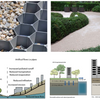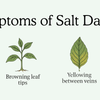What to do in your wicking bed this month - March 21

Posted: 3 Mar 2021 by Eric Sturman
Autumn gardening in your wicking beds
These are the Goldilocks weeks. Not too hot, not yet cold. With the hottest of the Summer days at our backs, the garden is a much more pleasant place at this time of year, but while the air temperature is dropping, the soil is still warm enough for a quick start on direct sowing. This blog will focus on the last chance you will get to direct sow a few Autumn and Winter crops in your wicking beds.
Wicking Bed Preparation between Crops
I have a patch of lettuce that I finished harvesting last week, and after turning through some compost and cow manure, I am ready to direct sow. So how much organic matter do you add between crops? Healthy soil contains between 5 and 10% organic matter. By volume, if I have a soil depth of 30cm in my wicking bed, then I will be adding a layer of between 1.5 and 3cm of organic matter to the surface and digging that through. This is a useful technique for building up soil in only a section of a garden bed. It may not be overly precise, but it is certainly close enough to ensure that you don’t deplete your soil of life. If you are planning on sowing beans, then don’t follow the next step. Beans invite a Nitrogen fixing bacteria into their roots and will do worse with Nitrogen fertilisers than without. For all other types of vegetables, you will want to add extra pelletised nitrogen as follows. Once the soil and organic matter are mixed, apply the pelletised fertiliser at the manufacturers rate, about a handful per metre squared, and mix through the top 10cm of soil. Level the soil and mulch the area to a depth of 2cm. If seedlings are going into the bed, then be sure to leave the bed for a week while the bacteria get to work. Direct sowing however will not require the soil to cure first. As the seeds will take around a week to germinate, the soil can settle before the seed wakes up.
Planting beans in your wicking bed
As I have mentioned before, root crops should always be direct sown. This is to eliminate the risk of root damage when transplanting. Beans and peas are also best direct sown as they are so quick to germinate and grow that you don’t really save that much time by starting them off to the side. If fact, they send down a long tap root so quickly that will fast outgrow a seedling tray, potentially stunting the growth of the seedling. Winter is Broad Bean time and Autumn is the time to get them in. The rule of thumb when planting any seed is that the depth should be twice the height of the seed. In the case of the broad bean, it is about 1.5cm in height, and so should be planted with 3cm of soil above it. The orientation of the seed in the ground is not important, it will right itself by the root responding to gravity and the shoot to light. Follow the sowing guide of the variety you have decided on, but it will be about 30cm spacings and may require support as it matures depending on the growth habit of that type. Construct any supports before planting. If you wait until the plant needs support, you will more than likely damage the root system when pushing the stakes into the ground. After planting the seeds, cover them with the 3cm of soil and gentled pat down to squeeze out any air. Sprinkle with a light layer of mulch to less than half a centimetre. Water once and not again. Broad beans are up and running in 10 days. By the time the shoot is visible above ground, the roots are well established and down to the moist layer of your wicking bed.
Water once and not again. Broad beans are up and running in 10 days. By the time the shoot is visible above ground, the roots are well established and down to the moist layer of your wicking bed.
Planting carrots in your wicking bed
Carrots are almost pest free and easy to grow all year round except for the very hottest weeks of summer. They are perfectly suited to wicking beds, as the main point of failure when growing carrots is inconsistent water. When stressed as seedlings from drying out and then being flooded, carrots can quickly bolt to seed before producing a fat healthy root. If you let them dry out as a more mature plant, the roots can crack and split, spoiling the crop. An often asked question is what soil depth do I need to grow carrots and does a wicking bed provide sufficient soil depth? There are many varieties of carrots and they all grow to different sizes. The vast majority of carrot varieties will grow to full maturity in only 20cm of soil. There are carrots that are round and the size of golf balls like the Parisian Heirloom all the way up to the World record variety 'Jumbo'. This with the Japanese Imperial Long, Gold Park, Autumn King or the Red Giant can grow to an enormous 60cm. According to the World Carrot Museum in the UK (real thing look it up) the average commercially grown carrot is 17.78cm long, 4.5cm round and weighs about 75grams. So, in answer to the question, 30cm is more than enough soil to grow a carrot.
Begin by preparing the soil as above including the pelletised fertiliser and, being a root crop, the carrots will benefit from an early application of Phosphorous mixed through the top 10cm of soil as well. Part the mulch in a line to expose the soil and in it make a very shallow trench in a straight line no more than a centimetre deep. Carrot seeds are very small and the way to ensure that you sow them evenly and to the correct depth is to mix the seeds with dry sand at a ratio of 1-part seeds to 100 parts sand. That is a quarter of a teaspoon of seeds to a quarter cup of sand. Pour the seed and sand mix into the trench level with the surrounding soil and water in lightly. Do not cover the trench back over with the mulch you shuffled to the side just yet. The seeds will take a little time to germinate, between 14 and 21 days, so be sure to keep the sandy strips moist. As the top layer of soil in your wicking bed will naturally be quite dry, you may need to lightly water every second day for up to three weeks. Once the seeds have germinated, they must be thinned out. Remove all the seedlings only leaving one plant every 5cm. Now the mulch can be gently moved back into place and an application of a half strength seaweed solution.
There are many varieties of carrots and they all grow to different sizes. The vast majority of carrot varieties will grow to full maturity in only 20cm of soil. There are carrots that are round and the size of golf balls like the Parisian Heirloom all the way up to the World record variety 'Jumbo'. This with the Japanese Imperial Long, Gold Park, Autumn King or the Red Giant can grow to an enormous 60cm. According to the World Carrot Museum in the UK (real thing look it up) the average commercially grown carrot is 17.78cm long, 4.5cm round and weighs about 75grams. So, in answer to the question, 30cm is more than enough soil to grow a carrot.
Begin by preparing the soil as above including the pelletised fertiliser and, being a root crop, the carrots will benefit from an early application of Phosphorous mixed through the top 10cm of soil as well. Part the mulch in a line to expose the soil and in it make a very shallow trench in a straight line no more than a centimetre deep. Carrot seeds are very small and the way to ensure that you sow them evenly and to the correct depth is to mix the seeds with dry sand at a ratio of 1-part seeds to 100 parts sand. That is a quarter of a teaspoon of seeds to a quarter cup of sand. Pour the seed and sand mix into the trench level with the surrounding soil and water in lightly. Do not cover the trench back over with the mulch you shuffled to the side just yet. The seeds will take a little time to germinate, between 14 and 21 days, so be sure to keep the sandy strips moist. As the top layer of soil in your wicking bed will naturally be quite dry, you may need to lightly water every second day for up to three weeks. Once the seeds have germinated, they must be thinned out. Remove all the seedlings only leaving one plant every 5cm. Now the mulch can be gently moved back into place and an application of a half strength seaweed solution.
Coriander
The last of the direct sown seeds to think about is Coriander. Coriander is notorious for bolting. There are slow bolting varieties, but it is really the hot weather that make this happen and with cooler days, this is a great chance to get some big fragrant healthy leaves to go with all the Asian greens that will no doubt be in your garden at this time of year. Coriander seeds lose viability very quickly, so be sure to use fresh seeds you have collected yourself or check the ‘sow by’ date on the packet. Don’t throw out of date seeds, some will still germinate, just a much lower percentage. So, sow them all. Coriander is best placed on top of the soil with a light covering of mulch on top and a good water in. Just the once will do and three weeks later the seedlings will start to emerge. As the seeds start to pop up it is time to sow some more to ensure a steady supply. If any readers have questions they would like answered and included in my next piece, please feel free to email me directly at eric.sturman@waterups.com.au-
Posted in
Category_Community Gardens, Category_Garden Wicking, Category_Project Groups>Commercial Projects, Category_Project Groups>Community Projects, Category_Project Groups>Horticulture Projects, Category_Project Groups>Landscape Projects, Category_Project Groups>Residential Projects, Category_Project Groups>School &, ELC Projects, School Gardens, WaterUps Featured








